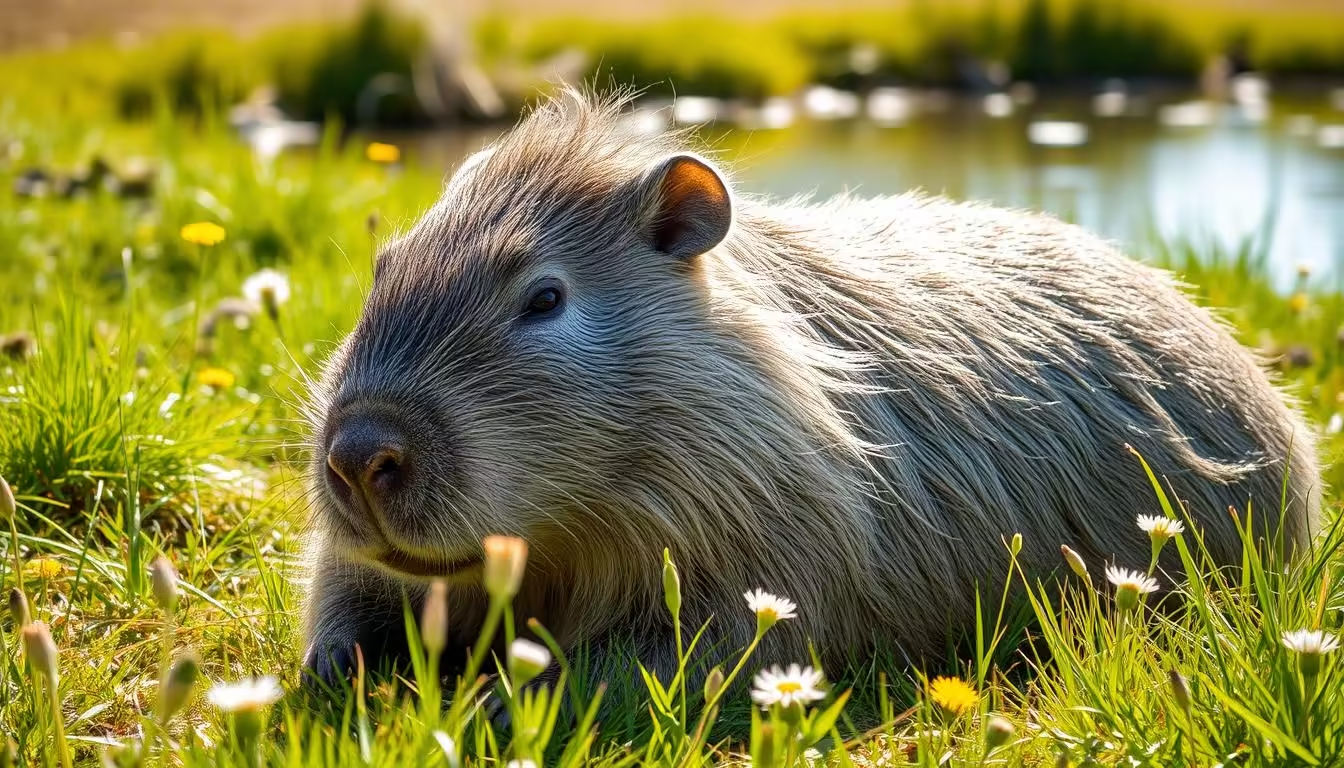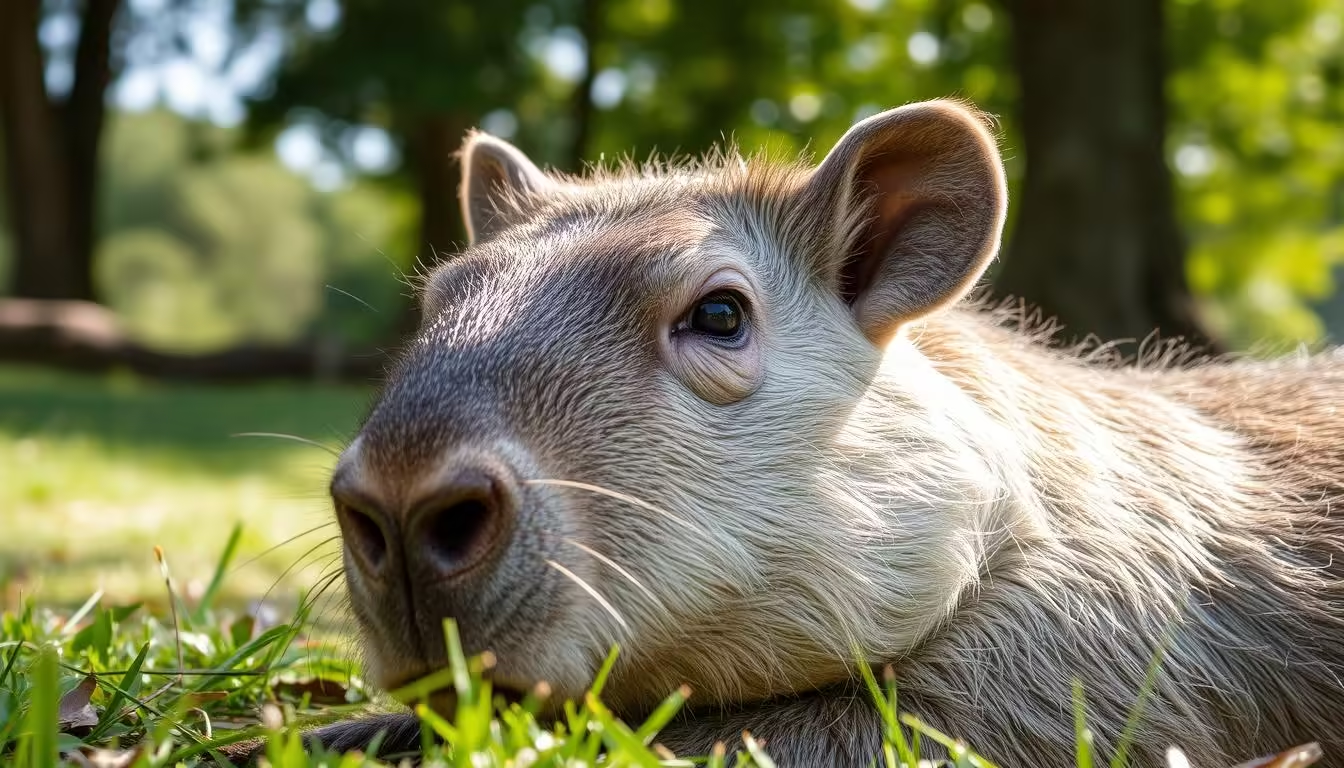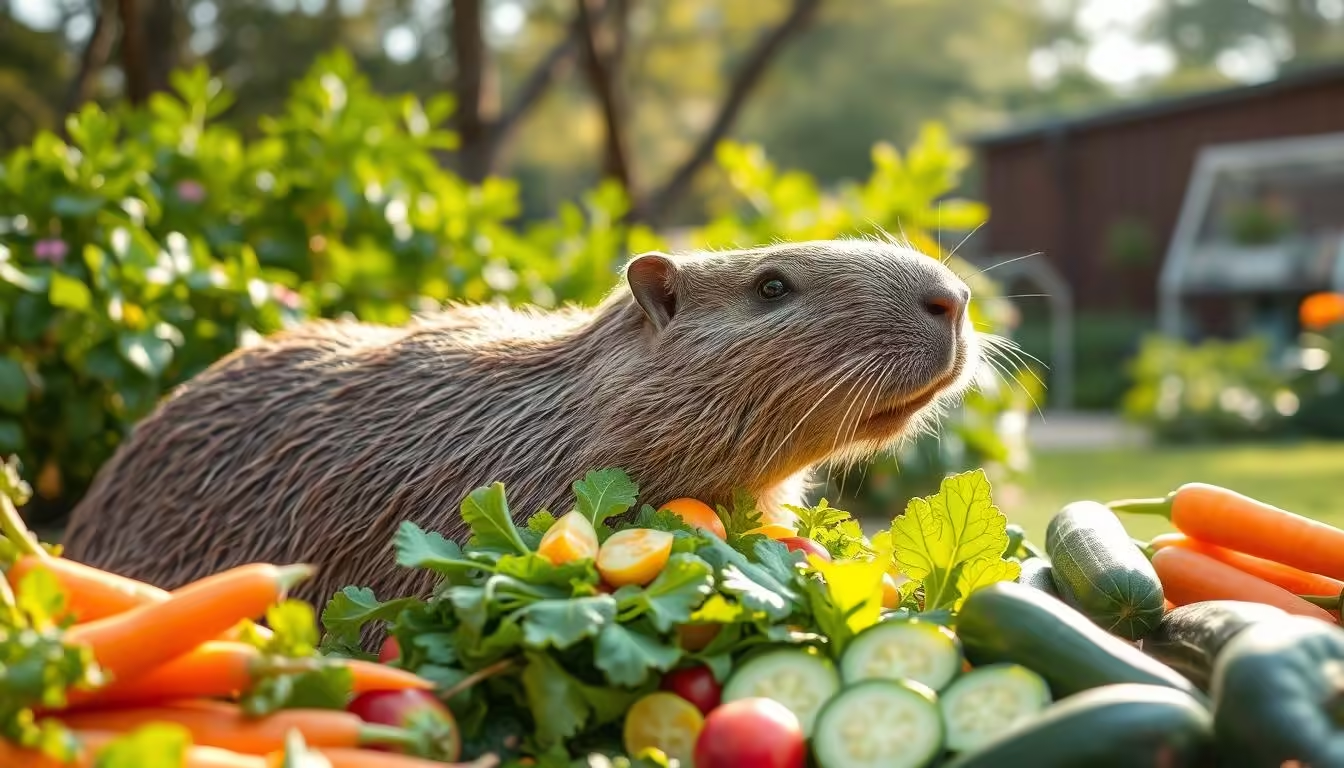As capybaras grow older, they show changes in their bodies and behavior. It’s important to know these signs to care for them properly. Changes like less nutrient absorption and slower thinking can affect their health a lot.
By spotting these signs early, we can help our aging capybaras live better. This means giving them the right food and care they need to stay healthy.
Key Takeaways
- Capybaras typically live 4-5 years in the wild and up to 10 years in captivity.
- Aging capybaras undergo physiological changes, including reduced nutrient absorption efficiency and decreased mental acuity.
- Proper care for elderly capybaras involves dietary adjustments, increased protein intake, and more frequent feeding.
- Signs of aging may include weight loss, decreased activity, and longer reaction times.
- Monitoring for these signs is crucial to provide senior capybaras with the tailored support they need.
Wild vs Captivity Lifespan Differences
The main reason for the big difference in lifespan is safety. In the wild, capybaras face dangers like jaguars and crocodiles. But in captivity, they are safe, living longer and experiencing more of their life.
Key Life Stages of Capybaras
- Juvenile: Capybaras become adults in 18-24 months, showing adult features and behaviors.
- Adult: For most of their life, they grow, thrive, and keep their abilities sharp.
- Senior: Around 7 years, they start to show signs of aging, like slower digestion and joint issues.
When is a Capybara Considered a Senior
In captivity, capybaras are seniors at about 7 years old. This is when they start to show more changes due to aging.
Physical Changes in Aging Capybaras
As capybaras get older, they may show signs of aging. These physical signs of aging in capybaras include muscle loss, less activity, and slower reactions.
One clear sign is weight loss. Older capybaras lose muscle, making them look thinner. Their fur may thin out too, showing more skin and making them look older.
Older capybaras also move less easily. They might not be as active as before. This is because they’re less agile and don’t want to do things they used to.
As capybaras age, they face more health problems. They might get diarrhea and fungal infections like Candida more easily. It’s key to watch them closely for these capybara old age symptoms and get vet care when needed.
| Physical Change | Description |
|---|---|
| Muscle Loss | Gradual decline in muscle mass leading to a thinner appearance and reduced body condition |
| Thinning Fur | Fur may thin out, making the skin more visible and giving the capybara a more aged look |
| Reduced Mobility | Older capybaras may have difficulty moving around as easily and their activity levels may decrease |
| Health Issues | Increased susceptibility to diarrhea and fungal infections, especially if the immune system is weakened |
“As capybaras age, they may experience a range of physical changes that can be indicative of the natural aging process.”
How to Tell if Your Capybara is Aging: Signs and Symptoms of Old Age
As your beloved capybara grows older, it’s key to notice the small changes that show aging. Knowing the signs of aging in capybaras helps you care for your senior pet well.
Behavioral Changes to Watch For
Behavioral shifts often signal that your capybara is getting older. You might see more napping or resting. Changes in how they interact with others or eat can also hint at aging.
Physical Symptoms of Aging
Physical changes are clear signs of aging in capybaras. Look for weight loss, moving issues, and changes in fur. Watching your capybara’s health closely can spot these signs early.
Mental Acuity Changes
As capybaras age, their minds may slow down. They might respond slower or seem less interested in their surroundings. Noticing these changes helps you know when they need extra care or routine changes.
By paying attention to your aging capybara’s behavior, body, and mind, you can meet their needs. This ensures they stay happy and healthy in their golden years.
Nutritional Requirements for Senior Capybaras
As our beloved capybaras age, their diet needs change. Senior elderly capybara nutrition and senior capybara diet are key to their health and happiness. Let’s look at what’s important for feeding our aging capybara friends.
Protein is vital for senior capybaras. As they get older, they need more protein to keep their muscles strong. They should eat high-quality protein from grass, veggies, and special rodent blocks for older animals.
Older capybaras might have trouble chewing hard foods. Softer or cooked meals can help. This way, they can still enjoy their food and get the nutrients they need.
Senior capybaras eat less but need to eat more often. It’s important to watch how much they eat and how often. This helps them get the nutrients they need.
Some senior capybaras can be picky about what they eat. It’s important to try different foods to make sure they get enough nutrition. Adding tasty fruits or treats can help them eat more.
It’s a worry if an elderly capybara loses weight too fast. In these cases, special formulas might be needed. Watching their diet closely is key to keeping them healthy and happy.
“Protein, vitamins, and omega-3 fatty acids have shown potential in improving the well-being of senior wild animals.”
Understanding our capybaras’ changing diet needs is crucial as they age. With the right food, care, and attention, they can live their golden years happily and healthily.
Changes in Mobility and Activity Levels
As capybaras get older, they might move less because of joint pain and muscle loss. Their movements slow down, making it hard for them to get around. It’s important to adjust their exercise to fit their new abilities.
Joint Health and Movement Patterns
Older capybaras often face joint problems like arthritis. This can make it hard for them to move freely. Their joints might get stiff and hurt, limiting their flexibility and making simple tasks tough.
Exercise Needs for Elderly Capybaras
- Provide low-impact exercises: Focus on activities that put less stress on the joints, such as swimming or gentle walking on soft surfaces.
- Encourage regular movement: Encourage your senior capybara to remain active, even if it’s just for short periods, to maintain muscle tone and improve joint flexibility.
- Modify the environment: Consider making adjustments to the capybara’s living space, such as adding ramps or non-slip surfaces, to make it easier for them to move around safely.
- Consult with a veterinarian: Discuss your capybara’s specific exercise needs and any mobility concerns with a veterinarian, who can provide personalized recommendations.
Understanding how aging affects capybaras helps you keep them happy and healthy. This way, they can enjoy their golden years fully.
| Measure | Young Capybara | Senior Capybara |
|---|---|---|
| Movement Speed | Agile and swift | Slower and less fluid |
| Joint Flexibility | Excellent range of motion | Decreased flexibility due to arthritis |
| Stamina | High endurance for physical activity | Reduced endurance, tires more easily |
| Exercise Needs | Requires regular, high-intensity exercise | Needs low-impact, gentle exercises |
Digestive System Changes and Eating Habits
As capybaras get older, their digestive system changes. Older capybaras may not absorb nutrients as well, leading to health problems. They often eat smaller amounts more often instead of big meals.
Dental problems are common in older capybaras. These problems make it hard for them to chew tough foods. So, they might choose softer foods, which can affect their diet.
It’s important to watch the digestive health of older capybaras. Signs like diarrhea can mean they have health issues. Watching their eating and any signs of discomfort helps spot problems early.
| Digestive System Changes in Aging Capybaras | Potential Impacts on Eating Habits |
|---|---|
|
|
Understanding capybara digestive health and elderly capybara eating habits helps caregivers. They can make better choices to keep their senior capybaras healthy.
“Maintaining a close eye on the digestive health and eating patterns of elderly capybaras is essential for ensuring their comfort and longevity.”
Dental Care and Common Mouth Problems in Aging Capybaras
As capybaras get older, they can face dental issues that affect their eating. It’s key to keep their teeth and mouth healthy. This way, they can still eat well and stay healthy.
Signs of Dental Issues
Look out for these signs if your senior capybara might have dental problems:
- Difficulty chewing or preference for softer foods
- Weight loss or poor body condition
- Excessive drooling or discharge from the mouth
- Discolored, swollen, or bleeding gums
- Reluctance to have their mouth examined
Preventive Dental Care
Regular dental check-ups are vital for senior capybara dental health. A vet can check their teeth and gums, spot problems, and treat them. Also, soft, easy-to-chew foods can help their teeth and gums.
For severe dental issues, elderly capybaras might need special diets or help eating. Cooking or blending their food can make it easier for them. By focusing on senior capybara oral care, owners can keep their pets happy and healthy.
Managing Common Health Issues in Senior Capybaras
As capybaras get older, they face more health problems. Their immune systems weaken, making them more prone to infections like Candida. They also might have digestive issues due to aging changes.
Keeping their environment calm and getting regular vet visits is key. This helps manage their health as they age.
It’s important to treat any illnesses or infections quickly. Senior capybaras have a harder time fighting off diseases. Working with vets who know exotic animals is crucial.
They can adjust care and spot health issues early. This way, owners can keep their capybaras healthy and happy in their golden years. With the right care, senior capybaras can live well and enjoy their later years.



